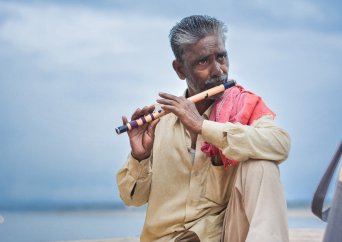- About
- Topics
- Story
- In-Depth
- Picks
- Opinion
- News
- Donate
- Signup for our newsletterOur Editors' Best Picks.Send
Read, Debate: Engage.
| topic: | Arts |
|---|---|
| located: | India |
| editor: | Bindu Gopal Rao |
Traditional folk songs are an integral part of Indian culture. In fact, the earliest records of Indian folk songs date back to 1,500 B.C. and are mentioned in Vedic literature. Folk music and folklore have been used as a means of celebration and express joy and have become an integral aspect of the social environment. Folk songs are also revered not only for providing entertainment, but also as a means of passing critical information from one generation to another.
While the state of Uttar Pradesh has a strong and diverse tradition of folk songs and dances, specifically Chithara village, in Dadri has as many as 193 folk songs with overtones from all communities, ranging from Aarti and Bhajan (devotional songs), Geet (songs sung during special occasions), Kissa (historical stories), Ragini (the local form of poetry and spoken words) and more.
This was discovered by a group of researchers from Shiv Nadar University during their research for an on-campus Biodiversity Documentation Program. Some of the villagers recalled the names of the plants or their uses through songs that they had learned.
The flip side, as the team found out, was that the younger generation using gadgets, technology and instant entertainment had almost forgotten about these tunes. The team, led by Dr. Jyoti Kumar Sharma from Shiv Nadar University, has helped the villagers document folklore and songs for the current and forthcoming generations so that this culture is not lost forever.
The process was not easy, however, as there was some resistance to share the lyrics of the songs. When the village head (Gram Pradhan) connected the University team with the villager who knew these songs, he was initially unwilling to share them, but with continued conversation he later shared a notebook with some rough notes of the songs.
Using this as a base, the University team started work on preserving these songs both in an audio-visual form as well as a book. The book called Folk Songs of Chithara Village in Upper Doab Region of Uttar Pradesh, India, has also been launched both in physical form as well as with digital access. The book also has an audio of the folk songs in a USB and the team has now documented about 300 songs.
The living heritage of songs, though intangible, is an important aspect of the cultural realm of a country and this project has given an impetus to make a positive impact for its preservation. More importantly, this is also a blueprint for similar projects that can work on preserving other aspects of the cultural diversity of India.
Photo by Jyotirmoy Gupta
